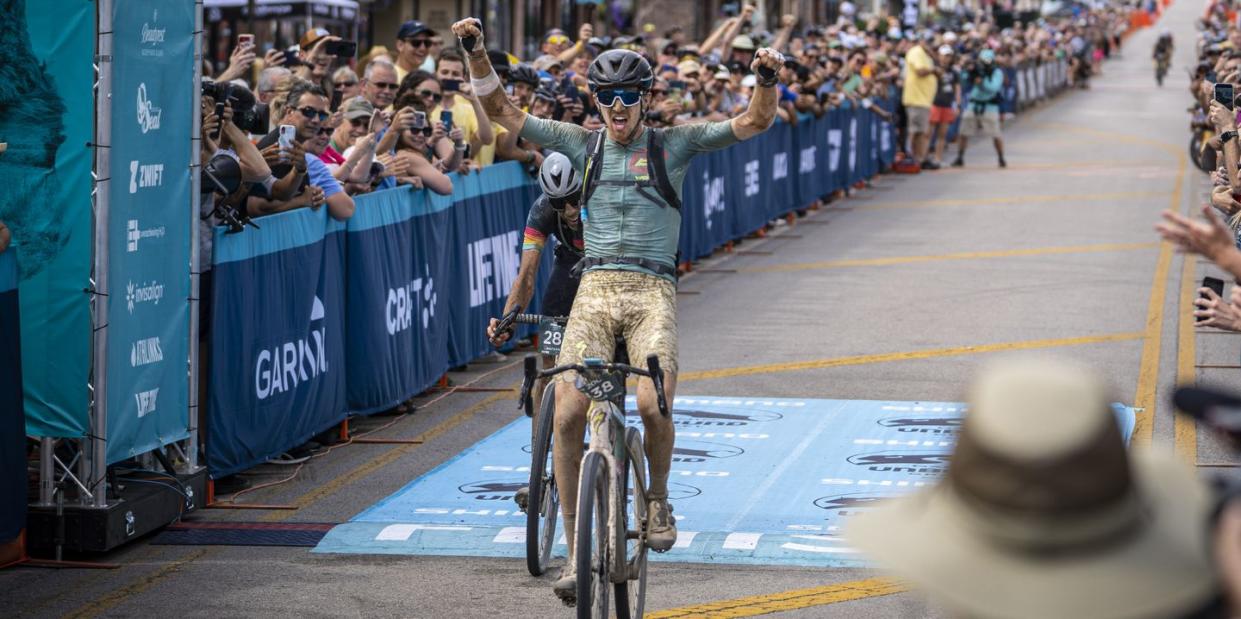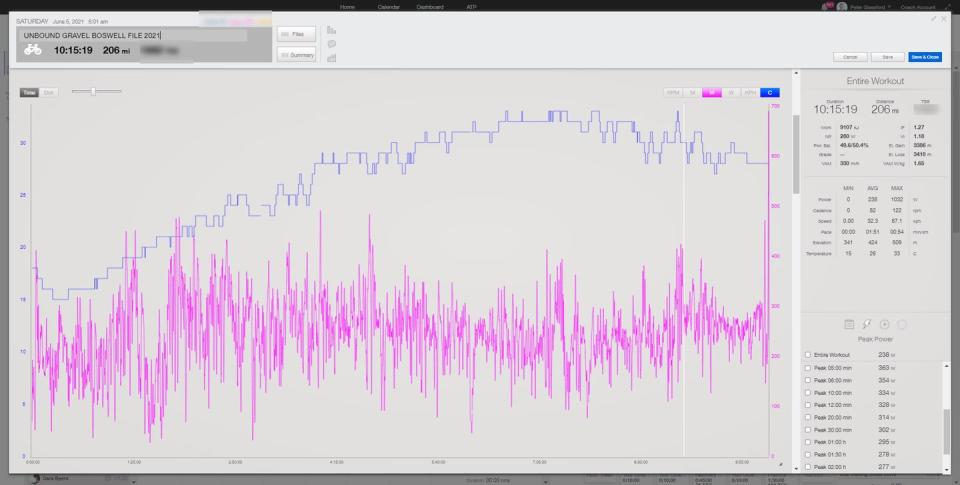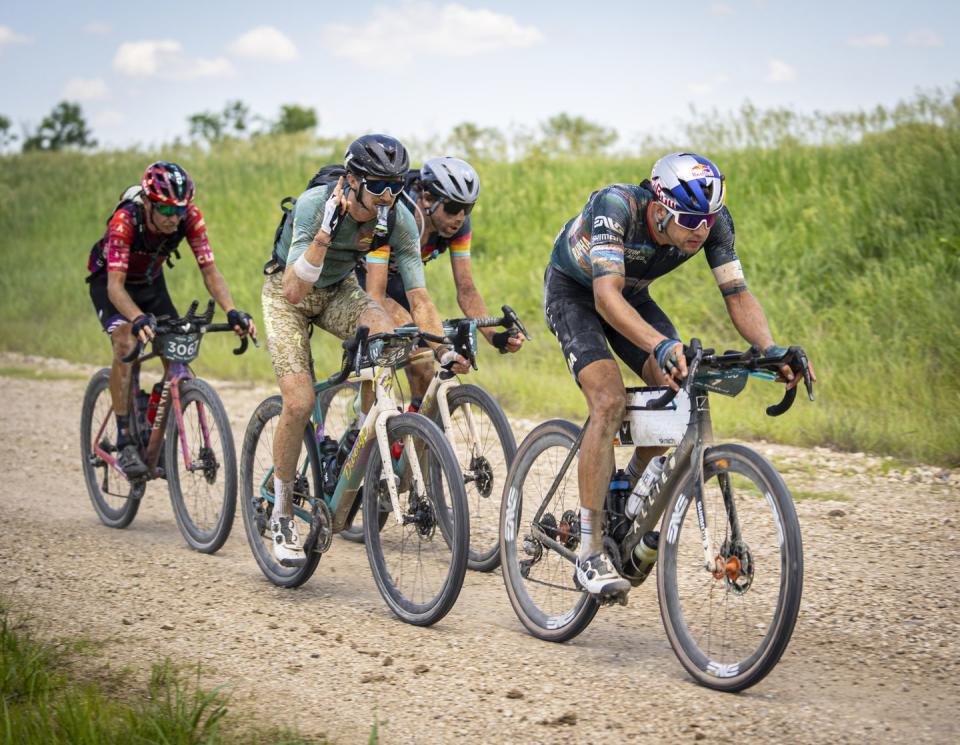Retired WorldTour Rider Ian Boswell Rode His Way to Victory at the 200-Mile UnBound

- Oops!Something went wrong.Please try again later.
When recently retired WorldTour rider Ian Boswell rode his way to victory at the 200-mile UnBound gravel grinder in Emporia, Kansas, on June 5, he hit over 1,000 watts for five seconds to outsprint Laurens Ten Dam.
But before that, he spent 10 hours and 15 minutes of racing putting out an average of roughly 3.4 watts per kilogram, expending 9106 kilojoules of energy to do so.
How did he do it? Smart training—and years of experience. Here, he and Wahoo’s sport scientist and elite level cycling coach Neal Henderson are digging into the numbers and pulling out some of the most interesting and useful data from the race. And it’s not all about being a pro: They have some tips about how to make Boswell’s tactics work for any rider.
UnBound isn’t WorldTour-fast, but it might be more challenging
In a WorldTour stage, riders averaging over 300 watts for five hours would not be uncommon, Henderson said. Boswell’s average for 10 hours was 247, or 3.4 watts per kilo for the entire event. But when you factor in the gravel and technical aspects as well as the duration, and then add in that final sprint, it becomes much more legendary.
This was Boswell’s second gravel event this year (and in general), and he admits that he was intimidated as the race got underway.
“This was my first time being in a pack that big, and first time being in a high-speed moving peloton since the crash I had in 2019. So I was a little bit nervous,” Boswell said. "The surfaces are more unpredictable. When we hit the first unmaintained section, I started to open up more of a gap to the people in front of me because I just wanted to be able to see where I was going. I wasn't willing to blindly follow the riders in front of me dow fairly kind of technical and rocky sections. I didn't want to risk crashing or flatting.”

The energetic toll is astounding
The most significant part of Boswell’s data, to Henderson, is the total kilojoules expended on the day—9,106, which is about equivalent to that many calories.
“I’ve coached World Tour riders and I’ve coached world record holders,” Henderson told Bicycling. “So it takes a lot to impress me when it comes to data. It has to be extraordinary realm for me. ... We don't have World Tour races that are 10 hours long, so seeing these numbers is significant.”
Over the course of the day, here’s what Boswell consumed:
Six bottles with a high-carbohydrate drink mix, around 400 calories each
More than 10 Picky Bars, at 200 calories each
A few gels and chews
“Some people choose to not eat solid food, but something that long, 10 hours, I was like, definitely going to be eating food,” Boswell told Bicycling. But I also knew it was important to eat food that I was familiar with, and that works with my body.”

Going hard is relative
What was most interesting to Henderson wasn’t Boswell's five-minute effort at 365 watts. Instead, he was most intrigued when he compared Boswell’s power file to Jeff Hoobler, a 54-year-old coach from Wahoo, who finished 74th at UnBound.
“If you look at the data on a relative scale, it’s interesting,” Henderson saiid. “Ian rode at around 62 percent of his FTP for the entire 10 hours, which is significant. But Jeff also averaged 61 percent of his FTP for his whole race. Ian’s normalized power was 70 percent of his FTP, and Jeff’s normalized power for the whole thing—for three hours longer—was 73 percent of his FTP. Their cadence was almost identical, right around 84 RPM on average. So in some context, you could say that finishing later, Jeff actually worked harder... In a relative sense. It’s interesting to me how similar the two of them were effort-wise.”
Riding at the front is smoother
Again, when Henderson compares Hoobler’s data to Boswell’s, it’s clear that they were in very different races. “There are those differences between what the winners are doing, even compared to someone further back in the top 100,” Henderson said.
When you’re riding with former pros and past UnBound winners like Ted King, Peter Stetina, Laurens ten Dam, and Colin Strickland, the first moments of jostling for position are quickly shifted into smoother sailing in a group that know what it’s doing. Behind them, the course’s challenging technical sections become more fraught as riders jockey for position in a scrum, and because of that, Boswell’s effort and average is smoother in the earlier parts of the race than a mid-pack racer.
“I’m very much a newcomer to this and wasn’t going to try change the dynamic of the race, especially in the first hour or two because I didn’t know how it would play out,” Boswell said. “It’s a 200-mile event, there are no teams, so the tactics are different. It’s up to the individual riders who ultimately want to perform at the end who are also somewhat responsible for setting the pace at the beginning. I know I wanted to be near the front to observe what happens, but I wasn’t going to attack or push the pace early.”
Don't look at power
You might think, based on this article, that Boswell stared at his power file all day long. Not the case.
“One of the unique things about a lot of gravel events is that you need your bike computer to navigate,” Boswell said. “Thankfully, the screen is big enough on the Wahoo Roam cycling computer that I could have the maps down below, and then time, distance, speed, and average speed.”
That’s right: No power or heart rate data.
“There’s actually some research that shows having too much information is fatiguing from a psychological perspective, which then has an impact on the physical," Henderson said. “Watching your power the whole race is just too much data that you can’t process or use. Especially when you have other inputs you need to focus on, like the route.”
Boswell used to spend his time during WorldTour races looking at power. But he’s learned that gravel events are won off of speed, not power.
“More often than not, these races are won as solo efforts, which means the person with the highest average speed is going to win the race. So I’ve done my longer training rides focused on maintaining average speed, aiming for 20 miles an hour. I don’t care about the power or heart rate or any other metrics, I just want to try to average at least 20 miles an hour. It’s taught me a ton of efficiency.”
You can do this in a race, but you should also practice learning perceived exertion, speed and efficiency, and working on navigation during your training as well.
“Create a screen on your computer that is exclusively like that with a map, speed, distance, and time,” Henderson said. “You can analyze power later; it is recording even if you can’t see it. The best athletes really do have this innate understanding that they've developed where they can tell you generally, what their power is within 10 watts, what their heart rate is within a few beats per minute, tell you how long they could hold that effort with the food and fuel they have on board.”
Stop training just with volume
You might think, looking at the numbers, that Boswell trains for upwards of 30 hours a week and does a ton of volume. In reality, Henderson said that Boswell averages under 20 hours per week. And as for 74th place Jeff Hoobler? He averaged around 11 hours a week in the weeks before UnBound.
An effort like Boswell’s to win UnBound didn't require a lot of long, slow distance, or even tempo work. Henderson ran the power file and found that Boswell spent 29 percent of the race at max aerobic power and eight percent at VO2 max. Sure, he spent 63 percent of his time around his FTP, but both he and Hooper spent a lot of time putting in harder work.
“If your training is exclusively long, steady stuff, like endurance and tempo with a little bit threshold,” Henderson said, “you’re going to be woefully underprepared for the event, even when it’s 10 hours long like that.”
You Might Also Like

